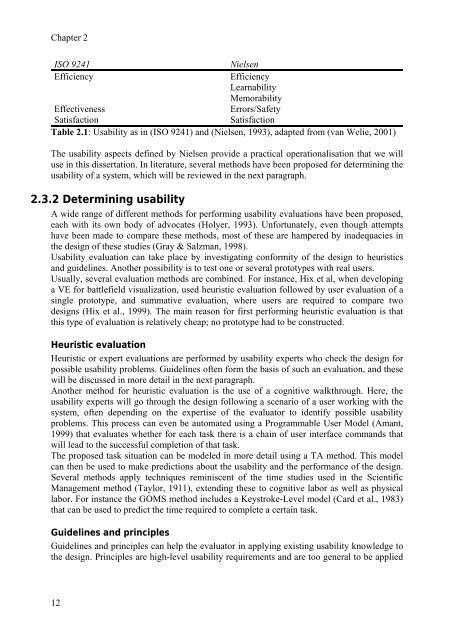Human-Computer Interaction and Presence in Virtual Reality
Human-Computer Interaction and Presence in Virtual Reality
Human-Computer Interaction and Presence in Virtual Reality
You also want an ePaper? Increase the reach of your titles
YUMPU automatically turns print PDFs into web optimized ePapers that Google loves.
Chapter 2<br />
ISO 9241 Nielsen<br />
Efficiency<br />
Efficiency<br />
Learnability<br />
Memorability<br />
Effectiveness Errors/Safety<br />
Satisfaction Satisfaction<br />
Table 2.1: Usability as <strong>in</strong> (ISO 9241) <strong>and</strong> (Nielsen, 1993), adapted from (van Welie, 2001)<br />
The usability aspects def<strong>in</strong>ed by Nielsen provide a practical operationalisation that we will<br />
use <strong>in</strong> this dissertation. In literature, several methods have been proposed for determ<strong>in</strong><strong>in</strong>g the<br />
usability of a system, which will be reviewed <strong>in</strong> the next paragraph.<br />
2.3.2 Determ<strong>in</strong><strong>in</strong>g usability<br />
A wide range of different methods for perform<strong>in</strong>g usability evaluations have been proposed,<br />
each with its own body of advocates (Holyer, 1993). Unfortunately, even though attempts<br />
have been made to compare these methods, most of these are hampered by <strong>in</strong>adequacies <strong>in</strong><br />
the design of these studies (Gray & Salzman, 1998).<br />
Usability evaluation can take place by <strong>in</strong>vestigat<strong>in</strong>g conformity of the design to heuristics<br />
<strong>and</strong> guidel<strong>in</strong>es. Another possibility is to test one or several prototypes with real users.<br />
Usually, several evaluation methods are comb<strong>in</strong>ed. For <strong>in</strong>stance, Hix et al, when develop<strong>in</strong>g<br />
a VE for battlefield visualization, used heuristic evaluation followed by user evaluation of a<br />
s<strong>in</strong>gle prototype, <strong>and</strong> summative evaluation, where users are required to compare two<br />
designs (Hix et al., 1999). The ma<strong>in</strong> reason for first perform<strong>in</strong>g heuristic evaluation is that<br />
this type of evaluation is relatively cheap; no prototype had to be constructed.<br />
Heuristic evaluation<br />
Heuristic or expert evaluations are performed by usability experts who check the design for<br />
possible usability problems. Guidel<strong>in</strong>es often form the basis of such an evaluation, <strong>and</strong> these<br />
will be discussed <strong>in</strong> more detail <strong>in</strong> the next paragraph.<br />
Another method for heuristic evaluation is the use of a cognitive walkthrough. Here, the<br />
usability experts will go through the design follow<strong>in</strong>g a scenario of a user work<strong>in</strong>g with the<br />
system, often depend<strong>in</strong>g on the expertise of the evaluator to identify possible usability<br />
problems. This process can even be automated us<strong>in</strong>g a Programmable User Model (Amant,<br />
1999) that evaluates whether for each task there is a cha<strong>in</strong> of user <strong>in</strong>terface comm<strong>and</strong>s that<br />
will lead to the successful completion of that task.<br />
The proposed task situation can be modeled <strong>in</strong> more detail us<strong>in</strong>g a TA method. This model<br />
can then be used to make predictions about the usability <strong>and</strong> the performance of the design.<br />
Several methods apply techniques rem<strong>in</strong>iscent of the time studies used <strong>in</strong> the Scientific<br />
Management method (Taylor, 1911), extend<strong>in</strong>g these to cognitive labor as well as physical<br />
labor. For <strong>in</strong>stance the GOMS method <strong>in</strong>cludes a Keystroke-Level model (Card et al., 1983)<br />
that can be used to predict the time required to complete a certa<strong>in</strong> task.<br />
Guidel<strong>in</strong>es <strong>and</strong> pr<strong>in</strong>ciples<br />
Guidel<strong>in</strong>es <strong>and</strong> pr<strong>in</strong>ciples can help the evaluator <strong>in</strong> apply<strong>in</strong>g exist<strong>in</strong>g usability knowledge to<br />
the design. Pr<strong>in</strong>ciples are high-level usability requirements <strong>and</strong> are too general to be applied<br />
12
















